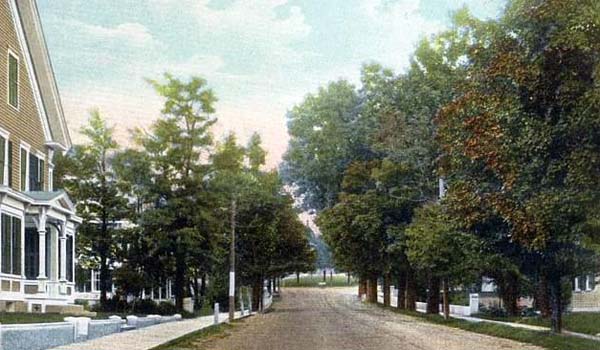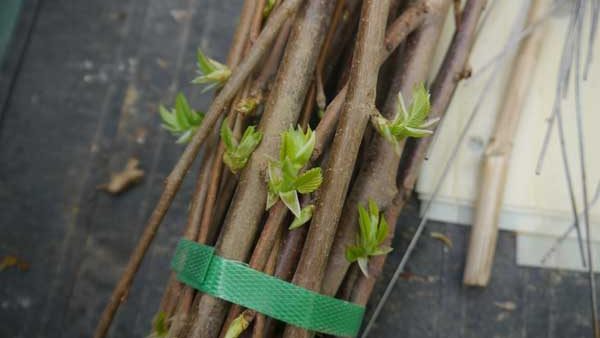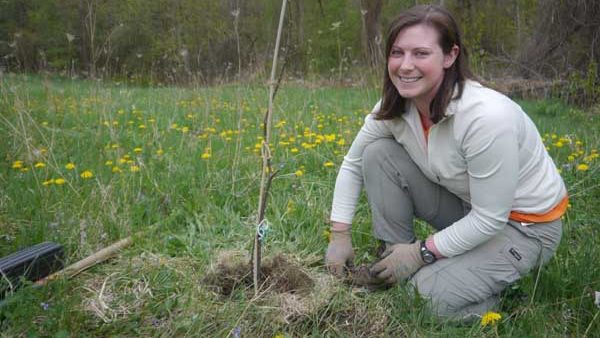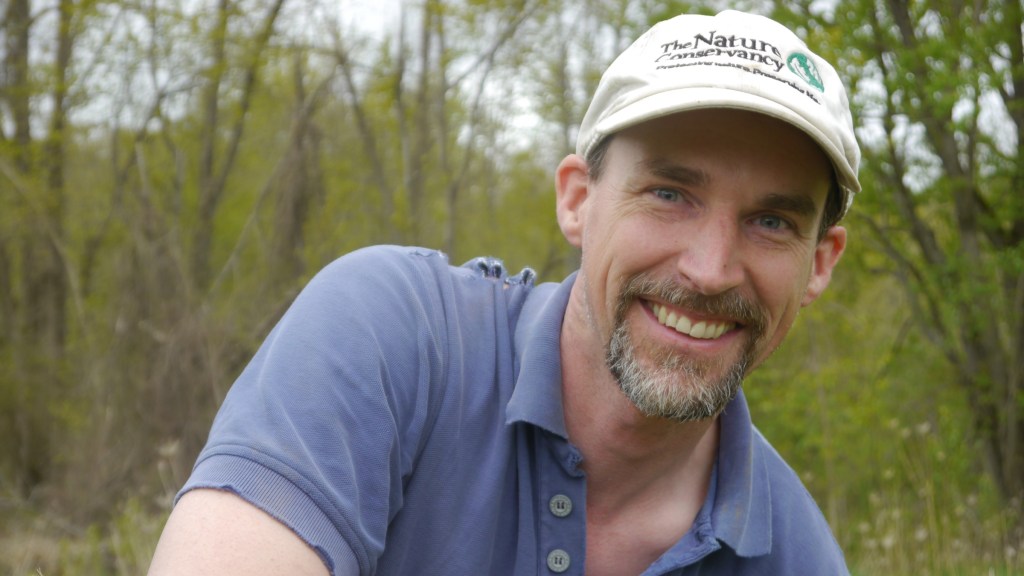Christian Marks runs a dating service. For elm trees.
As Marks sees it, American elms may be stunningly beautiful, but they could use far more help finding suitable mates than those unlucky-in-love singles scanning Match.com.
Marks, a floodplain ecologist for The Nature Conservancy’s Connecticut River program, is leading a research effort to restore populations of elms, once one of the most iconic and beloved trees in the eastern and midwestern United States.
Restoring trees might seem simple: plant them and they will grow. But in this case, it will require more than Arbor Day volunteers to return elms. Marks’ project involves quests for hidden survivors, sophisticated plant breeding, clones and extensive monitoring – all aimed at speeding up the process of natural selection.
Today, I’m joining Marks at Bartholomew’s Cobble, a Sheffield, Massachusetts preserve operated by the Trustees of Reservations, the second-oldest land trust in the country. It’s one of 21 elm tree restoration sites Marks is overseeing in four New England states, primarily located along the Connecticut River.
Marks is tamping down small elm seedlings into a poison ivy-strewn meadow. He has to be concerned about little things—whether rodents will gnaw through the bark, if the trees are spaced far enough apart. But in his eye, you can sense a much longer view. He’s seeing this meadow filled with stately trees.
“There are people who can still remember huge elms lining the streets,” he says. “They once would have formed magnificent stands in floodplains like this. They’re so ecologically important, and it’s hard to overstate their beauty. I think we can reestablish them here. But’s it going to take a lot experimentation.”

Fall of an American Icon
As canopy trees, American elms once affected the ecology of the entire floodplain forest, the rich, fertile habitat that periodically floods along rivers (and also provides flood control and cleaner water for people).
But most people knew them as trees of town and farm. They were the perfect tree for shade, to line city streets, to provide stately paths through college campuses. That is, until Dutch elm disease struck.
“American elms could take a lot of abuse, from roads, from salt, from pollution,” says Marks. “But they couldn’t take Dutch elm disease.”
Dutch elm disease follows the all-too-familiar script of the invasive pest story. Believed to have originated in Asia, it was identified in Europe in 1916. By then, it was too late—it raged through Europe’s elms and by 1928 was devastating forests in the eastern United States.
The disease itself has a complex ecology: spread by bark beetles, the fungus weakens the tree, which is then attacked by more bark beetles.
American elms had no time to develop resistance to the disease, and so they began disappearing. Fast. Some isolated pockets, like on college campuses, could be saved through expensive treatment. The city of Winnipeg still has 200,000 elms, the largest urban elm population in the world. The city spends $3 million annually on treatments. It still loses 1500 to 4000 trees a year.
That model won’t work in forests, where elms aren’t isolated and expensive treatment regimes are impractical.
Elm seedlings are resistant to the disease, which is not the blessing it may seem. When the trees are about one inch in diameter, they become susceptible. As such, there are still small spindly elms in the forest. But the stately masters of the ecosystem? They’re mainly gone.
Mainly.
But there are old monarchs out there. Some have survived due to their isolation: the lone tree in a cow pasture. Others, though, have been infected, and survived. They’re resistant.
They may hold the secret to returning the elm to its rightful place.

Surviving the “Flu Season”
Marks’ job, as he sees it, is to speed up natural selection. Given time, elms would likely develop resistance. But populations are too isolated for the resistance to develop in any meaningful time frame.
“The goal is to reach the point where Dutch elm disease is like the flu is for people,” says Marks. “Yes, you may get the flu, but the odds are you’ll survive.”
To do this means locating old elm trees that have survived multiple infections of Dutch elm disease. Marks follows any lead, although many turn out to be backyard and farmland trees that are not actually resistant, just isolated. Sometimes he hears about trees while in the field. In fact, during our planting trip, Bartholomew’s Cobble steward Rene Wendell directed Marks to an old surviving elm, a tree that Marks noted for future investigation.
(By the way, know where there’s a grand old elm, one more than three feet in diameter at breast height? Let us know via the U.S. Forest Service’s web site)
Once a tree is determined to be resistant, Marks and partners collect clippings for restocking. Here’s where experimentation is so important. “There isn’t a single genetic trait that provides resistance,” says Marks. “It involves multiple genes, so resistance is very complicated.”
Multiple strategies are employed, including cloning. While complicated, cloning allows researchers to plant a grove from one lineage, to gauge if resistant trees are able to withstand Dutch elm disease over multiple generations. “Dutch elm disease continues to evolve,” says Marks. “So we’re seeing if resistant trees can keep up with it.”
Another strategy involves breeding multiple resistant elms together, and then planting trees from a variety of stocks together.
“This is what I consider my dating service,” says Marks. “We have resistant trees from Ohio, from Pennsylvania, from the Midwest. They would never meet in nature. We’re putting them together and breeding them with each other. This creates more genetic diversity, and increases the chances resistant traits will be inherited by future generations of elm trees.”
The project has benefited greatly from partnering with Jim Slavicek at the Northern Station of the U.S. Forest Service in Delaware, Ohio.
The trees are planted in different environments and carefully monitored. Marks tags each tree, measures it and assesses its health. Some will prove, over the long term, to be susceptible to the disease. Others hopefully will prosper.
“Right now, about 19 out of 20 of the most resistant elm varieties survive infection,” says Marks. “That’s good, but it’s not high enough yet when you account for the disease’s evolution. We want to get up to 99 percent survival.”
An added complication will be when the trees begin to spread and encounter small, wild elms. “We don’t want the wild population swamping the resistant trees with susceptible traits,” he says.
That’s why many plant lineages and breeding and planting strategies will be essential for long-term success. “It’s conservation in the Anthropocene,” says Marks. “We’re using very sophisticated plant breeding to restore a more natural forest.”
It will take time, trial and error and lots of research to keep apace with an evolving fungus. But the rewards, says Marks, will be worth it. “Losing the elm had so many impacts on floodplain ecology,” he says. “It changed understory species, tree succession and flood control. And people really loved these trees. I can see a future where these beautiful giants are once again a part of our forest and culture. It means humans will have to be matchmakers for trees, but we can do it.”





Hi,
I am passionate about protecting and restoring the American Elm’s place in the forest and parks.
2 Questions: as I am also involved with TACF, do you do any collaboration with them ie. sharing and learning info? Also are you aware that there is a magnificent, mature American Elm by the Yardley Inn restaurant in Yardley, PA?
I can send you pictures of it. Ed Pfeiffer
Here on a rural homestead in south central Minnesota, we lost numerous elm trees to DED in the 70’s. Dad bought a wood stove and we heated the house with them, because what else? There was 3 of us boys.
After living elsewhere for 40 odd years, I am again living there, with a new found interest in trees. About six elms have survived. The largest one I ever remembered (approximately 3+ ft. Dia.) south of the old house, was sadly taken down to build the new house in 2012. The largest one remaining is about 24” dia., and I am in the process of cloning with cuttings. Never tried this before, but they have tiny leaves already. My hope is go future generations to remember a huge elm shade tree someday like we had .
Keep up the good work.
Like to help you. Have you tried introducing ded resistant genes? Have you talked to the people in Syracuse about their success with the resistant chestnut gene that they added ? I have been a supporter of the American Chestnut Foundation.
Ed Pfeiffer
609 581-1660
thanks for your work. it is important.
I have a 100 year old elm in good health in Chicago, Illinois. I need help from anywhere I can to try and save this tree. A developer has bought the house next door and plans on building on the lot which will seriously harm this tree and possibly kill it. We are trying any way we can to stop this developer, but it seems there are not legal rights. I welcome any feedback, direction from anyone who might know how to save this historic tree. Also, I am open to have seeds taken and grown elsewhere or used for whatever might help you.
Hi Kathy, Thank you for the comment! I recommend getting in touch with the lead for the entire elm restoration project ( https://www.nrs.fs.fed.us/partners/elm/ ), Jim Slavicek ( https://www.nrs.fs.fed.us/people/jslavicek ) to find out if they would be interested in screening your tree for resistance to Dutch Elm Disease.
why is this not a reality dating show……
Hello Matt,
I’ve just submitted the information about the massive, healthy, three-story tall, huge canopy elm tree apparently thriving in the back yard of the house we just bought in Hyde Park, MA, to the US Forest Service website you link above, but I wanted to extend a personal invitation to you and your crew to come see the tree and take cuttings, if you’d like. If you are ever in the Boston/Milton/Hyde Park area, please feel free to contact me and come on over!
Today while hiking, I found a huge old american elm tree on our property. It’s a majestic tree and it appears very healthy although, I did see where the local woodpeckers had been at work. I am going to try to measure the tree tomorrow. The girth is probably over 10 feet. We live in Nashville Tennessee. Is anyone working on restoring elms in Tennessee or surrounding states? Thanks.
There’s hope for the American elm! You may read about it here: http://mspmag.com/MSPMag/ElmTree/index.html
There’s hope for the American elm! You may read about it here:http://mspmag.com/MSPMag/ElmTree/index.html
Hello,
I would like to plant American Elm trees, but I’m concerned with Dutch Elm Disease. I have 34 acres in Kingston, TN and would like to plant elms down the driveway. I found a place that sells very small American Elm seedlings/small trees. What is the likelyhood of an American Elm avoiding Dutch Elm Disease? I know there are other similar Elms out there… What are your recommendations?
John L. Trotter
In North Adams, Mass. at the cemetery on West Main Street (between North Adams and Williamstown, there is a very large, very old Elm tree which as I drive by I keep thinking someone should clone that tree”. !
In North Adams, Mass. at the cemetery on West Main Street (between North Adams and Williamstown, there is a very large, very old Elm treem which as I drive by I keep thinking someone should clone that tree”. It must have just the right fertilizer to keep it living!